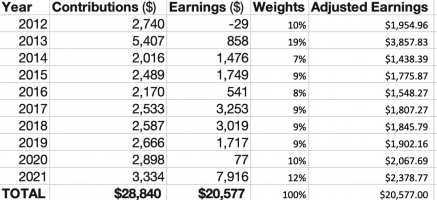Dear Forum,
I am assisting employees to evaluate their superannuation benefits and we have attempted to explain the elements of their individual accounts from the details supplied by their fund. I am in need of some guidance to provide a clearer analysis of the detail that has been supplied by their fund and we would appreciate any assistance you can provide on this matter. I have outlined this situation below:
Thank you.
Annual compound yield calculation
We are assisting our employees to evaluate the investment yields of their individual superannuation accounts. As an example, we have set out the details of one of our employees. During the period of 10 years, total member contributions = $28,840 and earnings for the same period were $20,577 accumulating to total benefits (at the end of 10 years) of $49,417.
Due to the wide fluctuations in earnings, we are attempting to restate the yields into a distribution of the $20,577 across the 10-year period, by using the weighted average or sum of the products method, or any other method that would be appropriate.
Although this is a theoretical exercise, it may help a member to understand the fluctuations that occur in a long-term investment.
Your help in this matter is very much appreciated.
Thank you.
I am assisting employees to evaluate their superannuation benefits and we have attempted to explain the elements of their individual accounts from the details supplied by their fund. I am in need of some guidance to provide a clearer analysis of the detail that has been supplied by their fund and we would appreciate any assistance you can provide on this matter. I have outlined this situation below:
Thank you.
Annual compound yield calculation
We are assisting our employees to evaluate the investment yields of their individual superannuation accounts. As an example, we have set out the details of one of our employees. During the period of 10 years, total member contributions = $28,840 and earnings for the same period were $20,577 accumulating to total benefits (at the end of 10 years) of $49,417.
Year | Contributions ($) | Earnings ($) |
| 2012 | 2,740 | (29) |
| 2013 | 5,407 | 858 |
| 2014 | 2,016 | 1,476 |
| 2015 | 2,489 | 1,749 |
| 2016 | 2,170 | 541 |
| 2017 | 2,533 | 3,253 |
| 2018 | 2,587 | 3,019 |
| 2019 | 2,666 | 1,717 |
| 2020 | 2,898 | 77 |
| 2021 | 3,334 | 7,916 |
| TOTAL | $28,840 | $20,577 |
Due to the wide fluctuations in earnings, we are attempting to restate the yields into a distribution of the $20,577 across the 10-year period, by using the weighted average or sum of the products method, or any other method that would be appropriate.
Although this is a theoretical exercise, it may help a member to understand the fluctuations that occur in a long-term investment.
Your help in this matter is very much appreciated.
Thank you.


